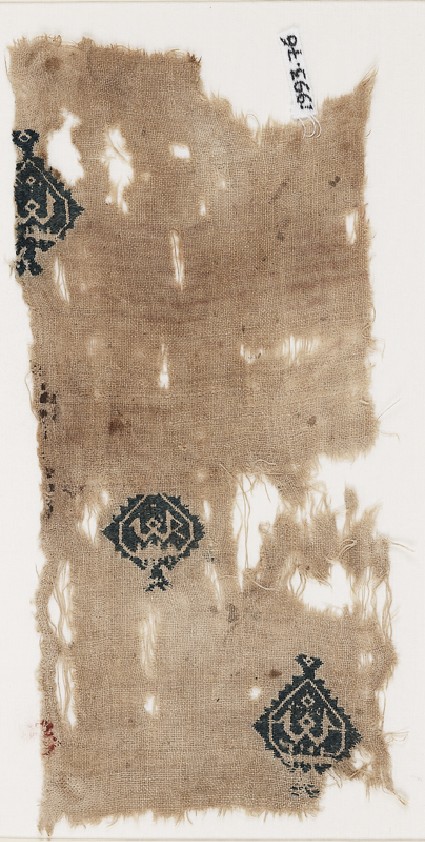Embroideries and Samplers from Islamic Egypt
A selection of 10th to 16th century embroideries from the Newberry collection at the Ashmolean by Marianne Ellis (published Oxford, 2001).

Publications online: 66 objects
- Reference URL
Actions
Textile fragment with diamond-shaped medallions containing a pseudo-Kufic word
-
Literature notes
The repeating motifs embroidered on this fragment have been arranged in offset rows which was a common way of creating all-over patterns on Mamluk textiles; these were sometimes worked in two colours, generally blue and red alternating. Beneath one, Professor Newberry pencilled in the word “health”. Evidently he thought the motif derived from the word al- 'âfiya (Arabic for good health, well-being) based on kufic letters repeated in mirror-image fashion. The motif appears in slightly different forms on several of the Newberry embroideries from the Mamluk period prompting the thought that the device was viewed as a protective or ‘good luck' symbol. However, it has also been suggested that it may have been derived from the word "Allah" and over time lost its significance.
This motif is particularly interesting because it provides more evidence that designs in early European pattern books were influenced by Mamluk textiles. A similar image was published in Schönsperger's pattern book, Modelbuch, of 1524 [illustrated in publication]. -
Details
- Associated place
-
Near East (place of creation)
- Material and technique
- linen, embroidered with blue silk
- Dimensions
-
ground fabric 25.4 x 11.3 cm (height x width)
ground fabric 17 / 18 threads/cm (thread count)
ground fabric 0.05 cm (thread diameter)
additional fibre, embroidery 0.07 cm (thread diameter)
- Material index
-
organic › animal › animal product › silk
- Technique index
-
woven › plain woven,assembled › woven › plain woven,
- Object type index
- No. of items
- 1
- Credit line
- Presented by Professor Percy Newberry, 1941.
- Accession no.
- EA1993.76
-
Further reading
Ellis, Marianne, Embroideries and Samplers from Islamic Egypt (Oxford: Ashmolean Museum, in association with Greenville: Curious Works Press, 2001), no. 18 on p. 32, pp. 8 & 34, illus. p. 33
Kühnel, Ernst, Islamische Stoffe aus ägyptischen Gräbern in der islamischen Kunstabteilung und in der Stoffsammlung des Schlossmuseums (Berlin: Ernst Wasmuth, 1927), cat. 3271, 65, pl. 38
Barnes, Ruth and Marianne Ellis, ‘The Newberry Collection of Islamic Embroideries’, 4 vols, 2001, Oxford, Ashmolean Museum, cat. p. 37 (vol. iv), illus. vol. iv p. 37
Glossary
kufic
-
kufic
A term denoting various styles of angular Arabic script. Emerged in the early centuries of Islam, kufic soon became the preferred hand to copy holy texts.
Location
-
- currently in research collection
Objects are sometimes moved to a different location. Our object location data is usually updated on a monthly basis. Contact the Jameel Study Centre if you are planning to visit the museum to see a particular object on display, or would like to arrange an appointment to see an object in our reserve collections.
Publications online
-

Embroideries and Samplers from Islamic Egypt
The repeating motifs embroidered on this fragment have been arranged in offset rows which was a common way of creating all-over patterns on Mamluk textiles; these were sometimes worked in two colours, generally blue and red alternating. Beneath one, Professor Newberry pencilled in the word “health”. Evidently he thought the motif derived from the word al- 'âfiya (Arabic for good health, well-being) based on kufic letters repeated in mirror-image fashion. The motif appears in slightly different forms on several of the Newberry embroideries from the Mamluk period prompting the thought that the device was viewed as a protective or ‘good luck' symbol. However, it has also been suggested that it may have been derived from the word "Allah" and over time lost its significance.
This motif is particularly interesting because it provides more evidence that designs in early European pattern books were influenced by Mamluk textiles. A similar image was published in Schönsperger's pattern book, Modelbuch, of 1524 [illustrated in publication]. -

The Newberry Collection of Islamic Embroideries
Three diamond-shaped medallions, each containing the same design of a pseudo-Kufic word possibly from al-mulk 'the kingdom'.
Notice
Object information may not accurately reflect the actual contents of the original publication, since our online objects contain current information held in our collections database. Click on 'buy this publication' to purchase printed versions of our online publications, where available, or contact the Jameel Study Centre to arrange access to books on our collections that are now out of print.
© 2013 University of Oxford - Ashmolean Museum


